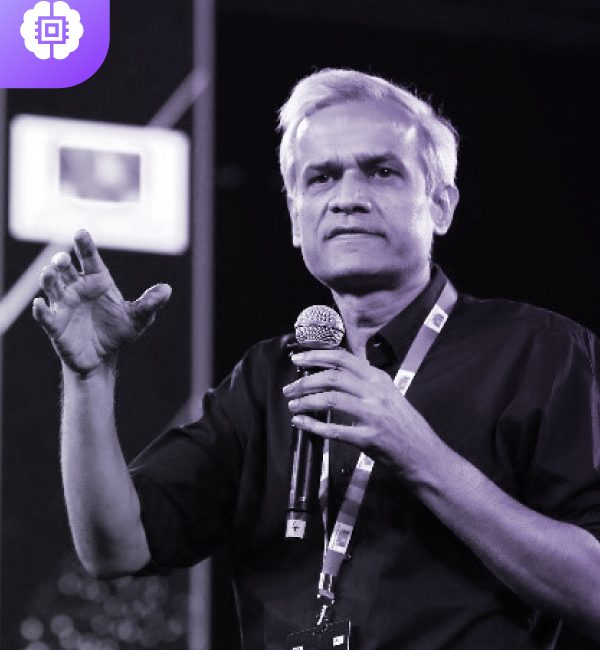
Entering the World of Phygital Stores with 6th Street
About this Podcast:
Joining us today is Karan Kunal, the Lead Product Manager at 6thStreet. Based in the GCC, Apparel Group’s e-commerce first platform, 6thStreet.com is a one-stop destination for all things fashion and apparel. Their Phygital store – which combines their online store with their physical store is truly an experience that takes omnichannel to a whole other level. In this conversation, we’ll talk to Karan about his journey at 6thStreet, how we’re creating unique customer experiences, and of course, an insight into how they’re planning on adopting tech in the near future.
Episode Transcript:
Hi and welcome. We're back with an all-new episode of the Retail Podcast by Vue.ai. I'm your host, Krithika Anand. With me today is Sanchita Suresh, Associate Director of Customer Success. In this episode, the spotlight is on Karan Kunal, Lead Product Manager at 6thStreet. We'll chat with Karan in just a minute, but here's a little bit about 6thStreet. Based in the GCC, Apparel Group's exclusive omnichannel e-commerce platform, 6thStreet is a one-stop destination for all things fashion and apparel. The Phygital store is truly an experience that takes omnichannel to a whole other level. In this conversation, we'll talk to Karan about his journey at 6thStreet, how we're creating unique customer experiences, and of course an insight into how they're adopting at 6thStreet. Hi Karan, it's great having you on our podcast. Welcome.
Karan KunalHi Krithika. Thank you for having me here.
Sanchitha SureshHey Karan, welcome to our podcast.
Krithika AnandSo why don't you start by telling us a little bit about what you do at 6thStreet and give our listeners what a day in your life looks like and what are some of the challenges that you face?
Karan KunalOkay. So as you know, I'm a Lead Product Manager with 6thStreet, primarily working on the purchase funnel. And I look after user engagement and, you know, anybody who is on the web, which is our PWA as well as our app iOS and Android, okay, whenever they land on the home page or any other property and how they go about discovering the products that they're looking to buy and maybe, you know some more, which they are not at that point of time, but we think they should. That is where the AI personalization comes into the picture, along with the fact that, you know, they have all the relevant details about the product, any kind of related product that we want to sell, so on and so forth. So and they go ahead and, you know, kind of add it to the cart and, you know, go ahead and make a purchase. That is the entire funnel that I'll look after here and then a general day in my life. It could be, you know, anything from talking to various stakeholders, be it business operations with regards to, you know, what are their pain points, what are the key challenges that they are facing with regards to both business operations as well as any kind of merchandising or customer-facing feedback that they have received. And also, you know, when when we are handling when we're discussing with platform teams like content and so on, so on, so any kind of, you know, tools and all those things that you are looking for to make their job easier. So those kind of things. And then going ahead, of course, we do our prioritization with regards to the business challenges that we want to, you know, kind of take on along with customer experience challenges. Definitely that we correlate with the effort that is going to go into it. And we get into a solution discovery mode wherein, you know, we speak to designers, we speak to engineers and come up with solutions. And, you know, once we have vetted, be it through prototyping or be it through smoke tests, so on and so forth, and then we go ahead and get a solution built and released. So a lot of the things is about talking to various stakeholders both upstream and downstream and, you know, figuring out what is the best way to solve certain problems. And also if there are any issues or bugs that we are facing, solving those things, speaking to customer service to see what are the feedbacks they have received based upon the NPS and the verbatim around it, and to see if there are certain things that we want to add in our roadmap. So those are the kind of typical day to day work that we do. I do. And it could be by my own, by with other product owners or product managers who are working on the similar or the same funnel. So that and then also speaking to some of the vendor partners that we have Vue being one of them, wherein they handle a key area of personalization. We have different touchpoints, so different issues, different problems, different challenges that we want to see different use cases that we want to target. So that is where we connect with them and figure out a way to, you know, kind of of of up the up the top lines and the bottoms. So yeah.
Krithika AnandWow, that's a long list. And yeah, all this sounds quite interesting, you know, and one thing that caught my eye was the user engagement aspect of it. We'll get to that in a bit. But let's quickly zoom out and understand that in the context of retail today, the last couple of years completely revamped and shaped the retail industry. And as someone who's been fully immersed in and navigated through the last three years in retail, how is this year different and what is something that you think retailers are and should be doing to grow?
Karan KunalOh, I think we are at a tipping point here with regard to what technology has to offer. Okay. It could be in terms of user engagement. It could be in terms of fulfillment. It could be in terms of order management, anything. So any touchpoint that you pick in a user journey, whether it's pre-order or post-order, okay? There is a technological revolution that is either happening or waiting to happen. So similarly, one of the key things that we have, you know, kind of heard about this year a lot is, you know, ChatGPT your generative AI, right? So that has a huge impact on that can have a huge impact on how we go about you know, catering to our customers with regards to personalized content. Okay, it could be in batch or it could be on the fly. So that is one area that definitely everybody would be looking to, you know, explore and make the best use of. And also with regards to users being happier or more content with what they find on the platforms. Right. With regards to the personalization or the recommendations that we give, there is a huge upside of scope in making it more and more personalized and attuned to their specific needs. And I believe with with with the advent of such technology wherein data crunching is in everybody's hand and, you know, with, with simple integrations, they can and data cleaning, they can, you know, get something which earlier required a huge amount of integration and so on and so forth. I think a lot of the smaller players are also going to get into that space and deliver superior customer experience. And so in one line I can say that democratization of the way user experience is personalized is going to happen probably this year or maybe next.
Krithika AnandRight. I think it absolutely rings true in this case. One point that stood out for me the most is data. It's safe to say that data is at the forefront. So why don't we dive deep into the most spoken topic today? So much of what you do is determined by and is also dependent on a plethora of product and customer data. What are some of the tools that you are using to make your life easier on a daily basis?
Karan KunalOkay. I mean data is pretty much everywhere, right? Mean? Right from the time. How clean and how neat is your taxonomy? That defines a lot of things. Even for mean be it with regards to shipping to the customer the right thing that they're, they're, they want along with the discovery part of it wherein the search works properly and along with also how what we send to Vue right with regards to the the the data, the product data bases on which they send out their recommendations. So everything is dependent on data. Okay. How well laid out how it is structured and how clean it is. Right. I mean I believe a few months back we were struggling with our personalization widgets on PDPM and Sanchitha would know this. So we were struggling with some of the recommendations that we were seeing and the clear-cut issue there was that the gender which was being passed was, uh, was wrong. Okay? We were seeing, uh, some of the products as being female-oriented, whether it was actually a male PDP that we were on or a male funnel that we were on. So, these are smaller things. So data is everywhere, is omniscient. So, the impact of it is also felt everywhere. And like right now, if I want to go ahead and let's say make a personalized PLP for you Krithika. So I need to understand what have you purchased. Okay. Mean what are the sizes that you wear for various apparel and shoes and all those things, right? So I need to have that 360 view of yours before I can go ahead and, you know, kind of personalize any of the screens or any of the touchpoints on my app or on my site. So that is where, you know, it becomes paramount that we first have the right data. We have the data in the right format, we have the data, which is clean so that, you know, once that is done, then and one of the use cases has been solved, we can pretty much go ahead and extrapolate it and extend it to other touchpoints as well. Right. I can go to and maybe some of the recommendations or some of the sizes that I want to show you. I can show you, the basis of your data. And also with regards to recommendations that we are showing. Currently, this is again, something that we have done in the last two months with you wherein we look into we factor in availability rate, right? So which again is a generic area, okay? It's not something that is very attuned to the specific user. So I can, if I know what sizes that you are looking for, I can go ahead and, you know, take out probably that and put in those sizes to filter my recommendations further. So it's everywhere, okay? I mean, I mean if you are sending PMS, okay, marketing PMS. Okay. There also, it can play a huge factor. So it's I mean, like any touchpoint that we talk about, right, pre-order, post-order marketing - so data is there.
Sanchitha SureshI completely agree with you. So just treading on that same line. Right. So you were talking a bit about, you know, the customer experience as a whole, right? Personalization and all of that. But from your experience, if you could, you know, throw a bit a bit of light on, you know, a more data-driven approach that, you know, you guys take from a 16th standpoint in general, before you take any decision on a customer experience that you're trying to implement. So any, you know, methodologies or any specific frameworks that you guys use that which is very data-driven that you take your decisions on.
Karan KunalSanchitha, any example like what would you want me to touch upon? Like analytics.
Sanchitha SureshIf you could talk a little bit on like, you know, like, like, you know, AB testing and how do you, you know, even you're talking about labeling of data and all of that, right? So what kind of measures that you guys take on your end to clean that up more on a retail, uh, overall experience? That'd be good.
Karan KunalOkay. See, everything has, you know, again, like data attached to it. Right. I mean, be it if we launch something. Okay, we want to understand what is the adoption of it and also, you know, how it is performing with regards to the baseline that we have set up. And a B testing framework is definitely one of them. Along with that, if you want to, you know, kind of have a lower impact, we can probably, you know, pick up a smaller market to launch something and see if things are working as they're intended to. They're not breaking anything in any existing flow. Okay. So let's say we launched. I mean, currently, the site is the app is divided gender-wise. Right? We wanted to kind of launch a landing page, which is gender agnostic. Okay. So we wanted to see how it impact not our adoption, not only our adoption for new users especially but also for also with regards to retention overall, 30-day retention, Right? So so there are two ways to go about it. One is definitely, you know, pick up a bigger market, do a B test or pick up a smaller market like Bahrain or somewhere. Okay. And kind of, you know, do launch it there and see how that particular cohort behave right from the day that we launched. So we did that. And, you know, there were certain learnings from that with regards to adoption, whether people are how far they are going, are they seeing more screens, Are they able to find the products that they're looking for easily, more easily than before? Are they converting more? Okay. Are they you know, does it increase our stickiness more with regards to your use? So those are the things that we studied and the basis that the decision whether to, you know, kind of launch it for the rest of the goals or not was taken. So so this is one way. The other way is wherein we kind of launched where we did the overhauling of our personalization widgets on so you would know about this, right so wherein we wanted to understand, you know, how we can further improve the quality of recommendations not only with regards to relevance, but also with regards to the sizes being available so that somebody is going ahead and, you know, kind of adding it to the cart more and more so. So that is where wherein we did a couple of iterations and we found that where the have improved right but the overall the so the way they have decreased but the overall attacks have increased so assisted attacks have increased. So therein now we found out that you know, I mean, yes, it does have an impact, but yeah, it is taking a hit on the relevance. So that is wherein you go back and you do further iterations as to, you know, kind of hit that sweet spot wherein both the and attacks move in tandem so that the overall conversion improves, overall improves. And like that, we also launched the exchange last year wherein again, we wanted to, you know, I mean, the hypothesis was that it's going to reduce the return rate and also going to improve our revenue realization, positive revenue realization, right? And of course, there was a concern about unit economics and delivery charges and all those things, but we set out with the right that we are looking to, you know, Target, which is LTV, right? Customer happiness and overall LTV. So so we did this. We kind of again, you know, in the same on the same line of partial testing or testing, we launched it in few of the regions to see how the hypothesis is performing. Right So it was great and that is wherein we went ahead and kind of you know launched it in the rest of the country. And through this journey we again you know kind of figured out yeah so wherein we figured out the certain data points were missing. Okay. I mean apart from user analytics, apart from usability and adoption, there are also there is also a reporting side of it, okay. Which were, which we had definitely thought about. But again, there are certain missing points. So so that is where the stabilization phase comes into the picture wherein not only the end user experience, but also the data related dependencies are taken care of before we go, you know, full-blown with the rest of the regions of with all the customers. Right. 100% customers. So all these things we do, we a, B testing is one. And again you know region wise it is one. Another one is wherein we start, you know, in a staggered manner. We start releasing something which is one person, 2%, 5%, 10%, and so on and so forth, to see how the behavior is, how the adoption is, and how is it working with the system.
Sanchitha SureshYeah, that's super interesting. Like, it's spot on, you know, those insights that you just gave. Um, just taking a quick tangent on, you know, what you said, which was something that, you know, wanted to touch upon was the LTV aspect, right? You're talking about the lifetime value of a customer. So would it be fair to say like, you know, you're also trying to extend this by, you know like you guys kind of revolutionized this true omnichannel experience by opening your first phygital store? I think that's I think it would be fair to say that, you know, the term in itself can be, you know, I would say trademarked by 6thStreet for bringing in something called phygital. So our understanding is, you know, with your first phygital store, people who are actually coming to your store and online, they kind of get this entire seamless experience of shopping at 6thStreet. So it'd be great if you could, you know, tell us what are the unique ways you can create this personalized journey for your customers and what kind of ROI are you seeing specifically, you know, in this in this phygital store context?
Karan KunalHaving a single customer view definitely helps. Okay. With regards to not only the browsing journey but also with regards to the interpretability of the cart and also with regards to instant gratification. Right? All these three things are where you know, the interoperability or the omnipresence of the user profile comes into comes handy. Okay. So a user who is looking for something and on the 6thStreet app or web okay can very well be in a mall where wherein we have our stores also available not just 6thStreet but also a lot of apparel stores which are available there. They can go in that and, you know, kind of of of try it out, something that they already are looking to buy, whether it's wishlist or cart and, you know, make a purchase then and there either add to cart and you know make a purchase there which can be delivered to their home or they can buy something directly from their store. And also with regards to Phygital, also the Phygital is a very new concept that, you know, that was spearheaded again by Dharman. And we had a brand launch and a great adoption on that as well, wherein people can go into the shop and, you know, browse using tablets and try it out in a very non-contact way wherein, you know, you go there, you select something and you know, then it is made available for you to try it out in the trial room. You go in there and it's a very robotic automation kind of thing, which is in play. You go, you try it out. If you want to buy, you can come out and, you know, make a purchase then and there on the app itself and the tablet itself. Or if you don't like it, you can send it back and you can just put it there on the hanger, come back, select something new, and go ahead and try it again, whether it's with size or whether it's with some other SKU that you're looking for, the item you're looking for. So again, that is also something, you know, if we have a customer 360 view or the customer profile which is there and the recommendations and the shopping experience is personalized. Okay? It transcends, uh, your interface. It transcends where you are. It makes use of the available resources with regards to the availability of items for trials, with regards to the availability of salespeople to help you out and to give you more information, assist you further, and it can also assist you with, you know, kind of making a purchase, collecting it there and there, or making a purchase and having it delivered at your home. It can help you with, uh, you know, exchanging something that you have bought online at a store. So the use cases and the possibilities are endless. And I'm very proud to say that 6thStreet has been able to, uh, you know, kind of harness quite a few of them, in fact, a lot of them with regards to what our omnichannel experience is. And it has been one of the key drivers for this has been the user profile being present throughout.
Krithika AnandAnd I think the experience itself sounds very exotic and it almost makes me want to go and experience everything that you do at 6thStreet. So tell us about this. Over the last couple of years, you've been working with Vue.ai To offer your customers an enhanced shopping experience. Could you tell us a little bit about that and how has it been working with us for so many years now?
Sanchitha SureshOnly good things.
Karan KunalIt has been great. I mean, mostly great. I would say. But definitely, you know, being on the user side of it from a business standpoint, not from the end customer standpoint. Okay. I will not always be happy. That's my job. Okay. So but yeah, I mean, with regards to personalization, with regards to I mean, our relationship or our interaction is primarily in terms of personalization, right? And trying to upsell or cross-sell and primarily, you know, kind of the, the KPIs that we try to hit is our AOVs and conversion. So if talk about those things, yes, we are working and we are you know, I mean, the tool is delivering as expected and it has been a great working relationship also with you. I mean, would not I mean, it's more like a partnership rather than, you know, a vendor-client relationship. I would also have to thank Sanchitha for that for being very you know, mean for always lending her time. You are being very proactive not just with regards to you know, kind of hearing from me and getting things done but also with regards to putting in her own two cents for all the discussions that we have had. And that has truly been the basis of our solution discovery. Okay. And you can always make something better, right? I mean, there is no question about that. And I believe with regards to personalization we have, we are just getting started. And even with Vue. So and that is where, you know, with the Vue customer success team, with the Vue data analysis analysts, and the product team and the engineering team working in the background, we have been able to go on a solution discovery phase every now and then and you know quickly churn out some of the results and, you know, see how, how good we are performing, you know, how much of a delta we are able to add to our conversion and our AOVs and then revenue as such. So it has been great. And it has also been what our other point I would really like to highlight is, is further trying to, you know. Or expand the influence of this personalization engine, not only on some of the earlier touchpoints that we had but to go ahead go further into cards, into the home page, and those things. So we are already in the process of personalizing our home page wherein we have started with a couple of touchpoints with regards to personalized brands and personalized L2 and L3 subcategories. So the hypothesis is again, you know, I mean as a customer would want to see things that are more attuned to my needs, okay? And also in tandem with what I want the platform or what 6thStreet has to offer with regards to their own collection, and their own new launches. So we have to have a combination of both. And we have been able to, you know, kind of do the former, which is the personalization, or do the latter, which is the personalization view. And the results are yet to be seen, but I'm pretty sure that is going to be great as always. And yeah, I mean see, the possibilities are endless, right? I mean, in today's world, anything which is not personalized in any, and every second that the customer is spending on your platform, if it is not personalized it's a lost opportunity is what I would say. Whether it's actually going to lead to a drop-off or not, okay. Is something to be seen. It totally depends upon the specific apps, and the specific context that has been set with regard to the category in which they are delving. But it should be personalized as much as possible, right? It should mean I mean, every customer should see something which is different from the other customer, not just for the sake of being different, but for the sake of being useful. So yeah, I think that is what has been the baseline for our use case discussions, our future roadmaps. And you know, again, the A/B testing framework that we have laid out to hit that sweet spot. So it's been great. And I believe like I said, I mean, the possibilities are endless and we have just gotten started.
Krithika AnandThat's amazing. And we're so glad to hear everything that you said. And I'm sure it's going to be a great synergy together. Just tying back to your previous response, where do you think the future of retail tech is headed and where do you see your org investing in tech?
Karan KunalA lot of automation. Okay. A lot of automation, heavy and personalization. Uh, a lot of AI coming into the picture, not just with personalization but with regards to other things as well. Like one of the things I've talked about is content generation graphics and uh, with regards to, you know, optimizing fulfillment, wherein, you know, the key factor could be your cost per shipment. How do we on the fly, you know, kind of, uh, reduce something like that given the, the on-ground or the physical infrastructure into picture? So, there are a lot of things. I mean, it's still I mean, we're still getting started with the thing from the world is, uh, with regards to how the business is being done. So yes, but these are the thoughts that we have. And, uh, yeah, let's see how it goes.
Krithika AnandThat sounds amazing. And the interesting thing is automation and AI is almost the very core delta of, you know, every company that we speak to. And it's interesting how 6thStreet is also looking to navigate in that space. Um, we're excited to see how 6 to 8 is scaling with tech. We've gotten some firsthand information about 6thStreet, but let's get to know more about you as well.
Sanchitha SureshSo we'd like to know a little bit more about the book you've written. If you could tell us something more about it, that'd be great.
Karan KunalOkay. You caught me off guard.
Sanchitha SureshThat was the plan.
Karan KunalI mean, see, I do have an analytical as well as a creative side I've always had and, you know, and that that thing has kept on manifesting into, into different things. So my latest muse is writing and kind of, you know, discovered five years back that okay, I mean I could write I knew but I can write more than technical documents and speeches and debates. I can write poetry. Okay. So and process. So I started writing that and yeah, how it is with most of the people, uh, some good Samaritans we call as friends. They pushed me to, you know, start putting it out there on Instagram, of course, which I started doing. And one thing led to another and then thought about getting it published and reached out to a few of the agents because the publishers typically do not take direct submissions. So this is the interest of the agent finalized one. And yeah, uh, the book Breadcrumbs came into being and Breadcrumbs is it's again poetry. It has to be philosophical, right? So it is a journey of life and transcends from, uh, you know, how you start, how you fall in love, how you fall out of love and you know how it leads to some kind of, uh, of, of life-changing experiences wherein, you know, uh, you, you understand what freedom is and it gives you, you know, the endless happiness, which is Rhapsody. And, you know, in between there's you kind of, you know, become a bit of a sage. So that's pretty much it's a life journey, okay? Right from the time you start, you know, understanding why you are here and what you want to do with it, whether you want to do something with it or not. Okay? And that's the state of being so, so, so those are the things which have been put in the work in the form of poems. And we are close to 80 odd poems in the book and we released it in the month of April start. And uh, yeah, the feedback has been great so far. I've always had some of dedicated, you know, loyal readers, and the new ones have come in and it's doing pretty well. I would say there are around 30-odd reviews on Amazon also on the book. So people have kind words to say is what I can say. So yeah, that's me, that's about the book. But apart from that, if you're more interested in me, I like traveling and you know I also mean typically not the non-touristy things. I would never go as I went to Singapore. I never went to see the Merlion because I was just not interested in seeing it. So that's what I do. Okay. Typically, wherever I see vehicles going, I take the other route. Okay, So, so that's how I travel. And along with that, yeah, I do have some interest in sports, like playing cricket, badminton. I was doing kickboxing and year back six months back.
Krithika AnandThat's amazing. Think I'm going to go grab a copy of that.
Sanchitha SureshReplace my copy.
Krithika AnandSo let's do a quick, rapid fire session before we end this. Are you ready, Karan?
Karan KunalI think.
Krithika AnandWhat's your favorite drink?
Karan KunalCoffee?
Krithika AnandMine too.
Karan KunalBlack coffee.
Krithika AnandWho's your inspiration and why?
Karan KunalWell, I can say my dad. I mean, he had always had a certain way of going about his things. He has been very, you know, kind of dedicated to his craft, but at the same time a little detached also. And that has been not only been the way he has, you know, carried about his life or his work, but that also has been his leadership style. Okay. Which allowed him to be very dedicated to his cause and, you know, very be very fair and very forward-looking. And so that is something that I also try to, you know, imbibe. It comes naturally to me as well. This is something I've realized over a period of time. So, yeah, I can say that.
Krithika AnandWhat advice would you give your young self?
Karan KunalMy young self. I mean, continue what you're doing. It's going to be awesome.
Krithika AnandWhat's your favorite food?
Karan KunalDepends. I mean, at times I really like something which is Indian and, could be Chinese at times.
Krithika AnandWhat's your favorite TV show?
Karan KunalI like, 24, the series. It came quite some time back, and it was an action series. And I like Blacklist - first three seasons of it. Friends, How I Met Your Mother, of course.
Krithika AnandNice. What's your favorite book?
Karan KunalI like The Fountainhead.
Krithika AnandThat's great to hear from you. We're looking forward to what's coming next for you and 6thStreet. We wish you all the very best. And that brings us to the very end of our podcast. Thank you so much for joining us on the podcast, Karan. It was a pleasure hosting you and listening to your thoughts on all things retail and tech.
Karan KunalAll right. Thanks for having me here. It's always been great to interact with the folks at Vue. There is always something new to learn and, you know, kind of understand new ways in which we can back the business and work together where, you know, we both learn from each other. AI is the future machine learning is the way to go about it, whether some of us like it or not. But yeah, and I think that with the judicious application of it and implementation of it, a lot of avenues or gates are going to be opened. And yeah, like I said, we are just getting started. And as much as we work in tandem, the more we have got to gain from this particular relationship.
Krithika AnandWe'll be back with another episode of the retail podcast where we're at until next time, it's Krithika Anand.
Meet your speakers:

Sanchitha Suresh
Associate Director - Customer Success, Vue.ai

Karan Kunal
Lead Product Manager, 6thStreet

Krithika Anand
Customer Marketing, Vue.ai





